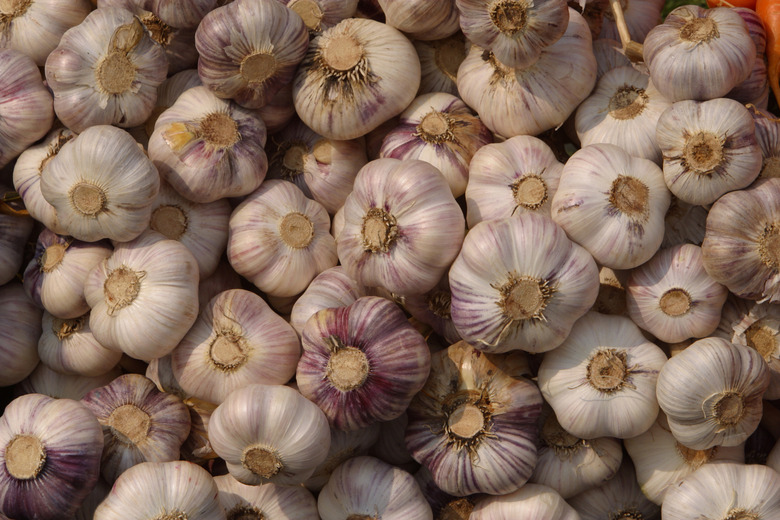What Causes Tips Of Garlic Plants To Turn Yellow Early In The Season?
While yellowing leaves are a sign that garlic (Allium sativum) is ready to harvest, yellowing leaf tips early on in the season are an indication that the garlic has growing problems likely invisible above ground. If the leaves of the garlic die off too soon, not enough nutrition will be provided to the plant, and it may experience reduced, or in extreme cases, no bulb or head development. A cool-weather vegetable that can tolerate some frost, garlic thrives when grown in direct sunlight, and the leaves are vital for photosynthesis to feed the plant. Garlic grows best in U.S. Department of Agriculture plant hardiness zones 3 through 8.
Irrigation
Step 1
Too little water will cause the leaves of the garlic plant to prematurely yellow. With too little water, the plant becomes stressed; and if left too long like this, the garlic will die. However, when watered too much, garlic can drown from waterlogged soil. Garlic prefers regular, steady, even irrigation, requiring 1 inch of water per plant per week. To maintain steady moisture levels in the soil, mulch your plants.
- While yellowing leaves are a sign that garlic (Allium sativum) is ready to harvest, yellowing leaf tips early on in the season are an indication that the garlic has growing problems likely invisible above ground.
- If the leaves of the garlic die off too soon, not enough nutrition will be provided to the plant, and it may experience reduced, or in extreme cases, no bulb or head development.
Diseases
Step 1
White rot or basal rot cause the underground heads of garlic to rot, leading to yellowed leaves above ground. Basal rot will kill a garlic plant more quickly than white rot and is usually invisible above ground until the leaves begin to yellow. In some cases, white rot may be visible at the base of the leaves near the soil. Dig up your infected plants as soon as you realize they have rot to prevent it from spreading to other healthy plants, and do not plant garlic or onions in the same spot the next year.
Nematodes
Step 1
You can't see them with the naked eye, but nematodes, worm-like parasites, can damage garlic bulbs, which will lead to yellowed leaves and a poor harvest. Rotate your crops each year to prevent nematodes from infesting an area of your garden. Do not plant garlic in places where members of the onion family have grown in previous years. Similarly, keep the area free of weeds to prevent a nematode infestation from taking root. Once it has started, a nematode infestation is almost impossible to stop; and when severe enough, you could lose your entire harvest.
- White rot or basal rot cause the underground heads of garlic to rot, leading to yellowed leaves above ground.
- Dig up your infected plants as soon as you realize they have rot to prevent it from spreading to other healthy plants, and do not plant garlic or onions in the same spot the next year.
Onion Maggot
Step 1
The larvae of onion maggots eat the tender, still-developing young garlic bulbs. When an infestation is strong enough, the plant will die. Above-ground symptoms include yellowed, wilting leaves and tips of leaves that turn brown. You'll also notice small tunnels in the heads and cloves of the garlic. Remove infested plants as soon as you realize they have an onion maggot infestation. To help avoid onion maggot infestations, use a floating row cover. Also, do not plant garlic in areas where members of the allium family grew in recent growing seasons.
- The larvae of onion maggots eat the tender, still-developing young garlic bulbs.
- Remove infested plants as soon as you realize they have an onion maggot infestation.
References
- Harvest to Table: Onion Family Growing Problems
- Barbolian Fields: What's Wrong with My Garlic?
- Cornell Univeristy: Garlic
- University of Minnesota Extension: Growing Garlic in the Home Gardens
- Royal Horticultural Society: Garlic
- Cornell University: Diseases of Garlic
- Cornell Cooperative Extension: Growing Garlic in the Home Garden
- University of Georgia: Garlic Production for the Gardener
- The Old Farmer's Almanac: Garlic
